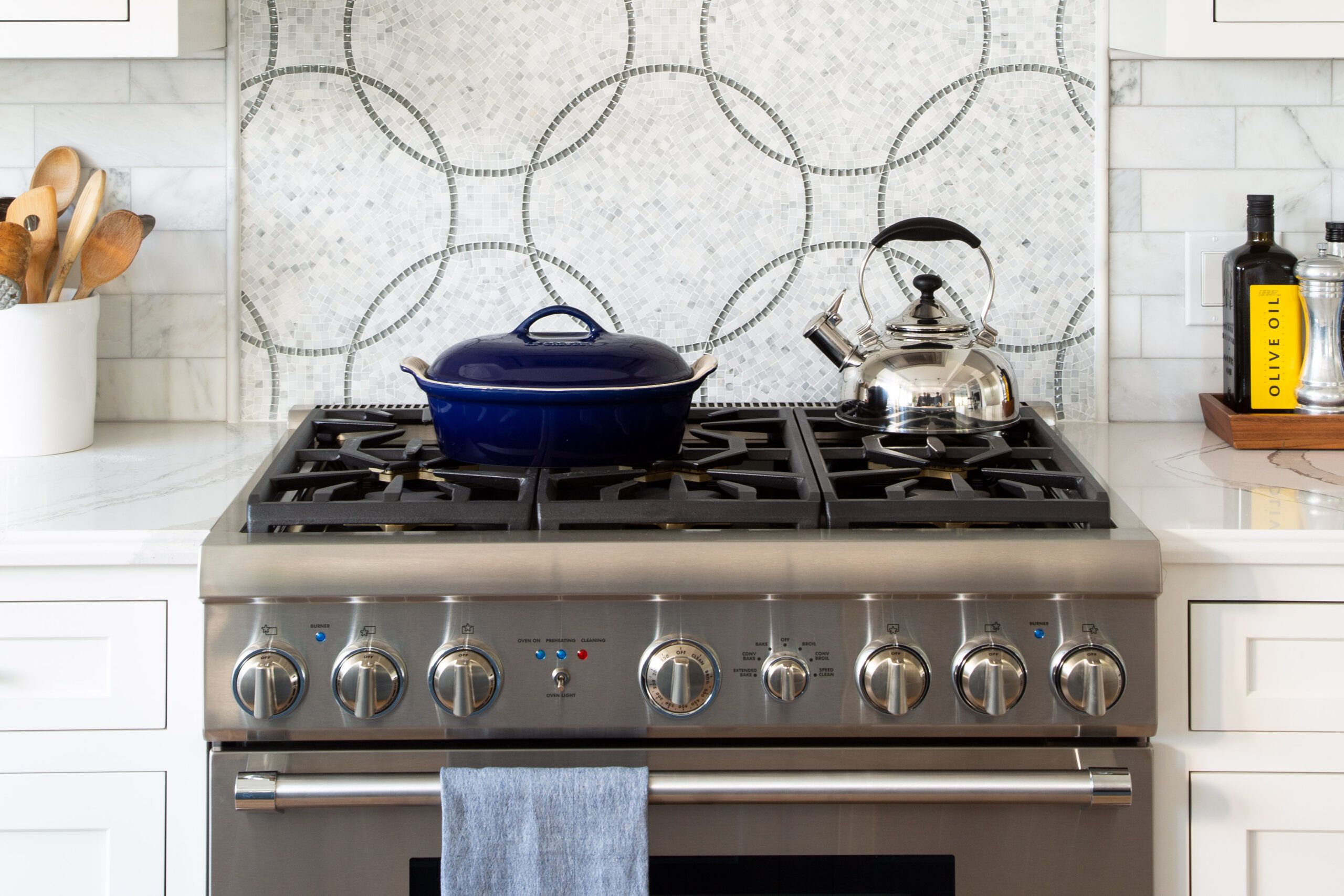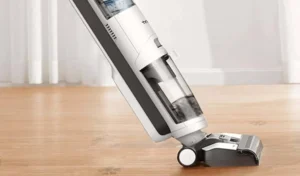To clean a gas stove, follow these steps: start by removing the grates and burner caps, soak them in warm water and dish soap, scrub them clean, wipe down the stovetop with a mixture of vinegar and water, clean the burners with a toothbrush and soapy water, dry everything thoroughly, and reassemble the stove. Cleaning a gas stove regularly is essential for maintaining its efficiency and ensuring safe operation.
However, the process can seem overwhelming if you don’t know where to start. We will provide you with a step-by-step guide on how to clean a gas stove effectively. By following these simple steps, you’ll be able to keep your gas stove looking clean and functioning properly for years to come.
Gather Essential Cleaning Supplies
Before you start cleaning your gas stove, it’s important to gather all the essential cleaning supplies. Having the right tools at hand will make the cleaning process much easier and more efficient. Here are the supplies you’ll need:
Mild Dish Soap
Mild dish soap is an essential ingredient in your gas stove cleaning arsenal. Not only does it help to cut through grease and grime, but it’s also gentle enough to use on the delicate surfaces of your stove. Look for a dish soap that is specifically labeled as mild or gentle to ensure you are not using any harsh chemicals that can damage your stove.
Baking Soda For Tough Stains
Baking soda is a versatile and powerful cleaning agent that can effectively tackle tough stains on your gas stove. It works wonders on baked-on food, stubborn grease, and even burnt-on residues. Sprinkle a generous amount of baking soda on the stained areas and let it sit for a few minutes before scrubbing with a soft-bristled brush.
Soft-bristled Brush
A soft-bristled brush is a must-have tool for cleaning your gas stove. It allows you to scrub away dirt and grime without scratching or damaging the surface of the stove. Look for a brush with bristles that are firm enough to remove stubborn stains but gentle enough to avoid causing any damage.
Microfiber Cloths Or Sponges
Microfiber cloths or sponges are excellent for wiping down and polishing your gas stove. These soft and absorbent materials can effectively pick up dirt, grease, and spills without leaving behind lint or streaks. Make sure to have a few microfiber cloths or sponges on hand to ensure a thorough and streak-free cleaning.
Protective Gloves
While cleaning your gas stove, it’s important to protect your hands from harsh cleaning chemicals and potential injuries. Wear protective gloves to shield your skin from any harmful substances and to prevent your hands from getting dirty. Choose gloves that are durable, waterproof, and comfortable to wear throughout the cleaning process.

Credit: www.thisoldhouse.com
Gas Stove Disassembly Steps
Cleaning your gas stove regularly is crucial for maintaining its performance and longevity. One important step in the cleaning process is disassembling the stove. This allows you to access hard-to-reach areas and thoroughly clean every component. In this section, we will guide you through the gas stove disassembly steps to make the cleaning process a breeze.
Turning Off The Gas Valve
Before starting the disassembly process, always ensure the gas valve is turned off to avoid any gas leaks or accidents. Safety should be a top priority when working with gas appliances. Follow the steps below to turn off the gas valve:
Procedure:
- Locate the gas valve usually positioned behind or under the stove.
- Rotate the valve clockwise until it is completely closed.
- Once the valve is closed, verify that the gas supply has been shut off by trying to ignite the burners.
Removing Grates And Burners
After the gas valve is turned off, it’s time to remove the grates and burners. This step will allow you to clean loose debris and grease residue that has accumulated over time. Make sure to follow the instructions below:
Procedure:
- Allow the stove to cool down completely.
- Gently lift the grates from the stove surface and set them aside.
- Take each burner and twist it counterclockwise until it releases from the stove.
- Place the burners next to the grates for cleaning.
Detaching Knobs And Any Removable Parts
Next, you need to detach the knobs and any other parts that can be removed for better cleaning access. This step ensures that no residues are left behind and every part of the stove is thoroughly cleaned. Follow the steps below to detach the knobs and other removable parts:
Procedure:
- Identify the knobs on your gas stove.
- Gently pull each knob away from the stove to remove it.
- If there are any additional removable parts, carefully detach them according to the manufacturer’s instructions.
- Set aside the knobs and removable parts for individual cleaning.
Following these gas stove disassembly steps will prepare your appliance for a thorough cleaning. Remember, regularly cleaning your gas stove not only keeps it looking great but also ensures safe and optimal performance. Stay tuned for the next section to learn how to clean each component in detail.
Cleaning Stovetop And Burners
Cleaning the stovetop and burners of your gas stove is essential to maintain its performance and appearance. Over time, grease, spills, and food particles can accumulate on the stovetop and burners, affecting their efficiency and making your cooking experience less enjoyable. In this section, we will guide you through the step-by-step process of cleaning your gas stove’s stovetop and burners to ensure they are sparkling clean and working efficiently.
Soaking Grates And Burners In Soapy Water
The first step in cleaning your gas stove’s stovetop and burners is to remove the grates and burners and soak them in a mixture of warm water and dish soap. This helps to loosen any stubborn food particles and grease, making them easier to clean. Here’s how you can do it:
- Remove the grates and burners from the gas stove.
- Fill a sink or basin with warm water and add a few drops of dish soap to create a soapy solution.
- Place the grates and burners in the soapy water, ensuring they are completely submerged. Allow them to soak for at least 15-20 minutes to loosen the grime.
- After soaking, use a brush or sponge to scrub away any remaining residue or debris.
- Rinse the grates and burners thoroughly with clean water to remove any soap residue.
- Allow the grates and burners to air dry before placing them back on the gas stove.
Applying Baking Soda Paste To Heavy Buildup Areas
If you notice heavy buildup or stubborn stains on your gas stove’s stovetop and burners, using a baking soda paste can help to effectively remove them without causing any damage. Follow these steps:
- Mix baking soda with a small amount of water to create a thick paste.
- Apply the baking soda paste to the areas with heavy buildup or stains.
- Allow the paste to sit on the stovetop and burners for 10-15 minutes to break down the grime.
- Using a damp cloth or sponge, gently scrub the affected areas in a circular motion.
- Rinse the stovetop and burners thoroughly with clean water to remove any residue.
Scrubbing Gently With A Brush On Burners
Once you have soaked the grates and burners and removed any heavy buildup with baking soda paste, it’s time to give the burners a gentle scrub to ensure they are completely clean. Follow these steps:
- Using a soft-bristle brush, gently scrub the burners to remove any remaining residue or debris.
- Pay close attention to the small holes or slots on the burners to ensure they are not clogged with dirt or grease.
- Rinse the burners thoroughly with clean water to remove any loosened particles.
- Dry the burners completely before placing them back on the gas stove.
By following these simple steps, you can effectively clean your gas stove’s stovetop and burners, keeping them in top-notch condition and ensuring optimal performance. Regular maintenance and cleaning will not only enhance the appearance of your gas stove but also contribute to a safe and enjoyable cooking experience for years to come.
Cleaning Control Knobs And Stove Surface
Learn how to effectively clean gas stove control knobs and surfaces with this step-by-step guide. Keep your stove looking spotless and hygienic with simple and effective cleaning techniques.
Wiping Down Knobs With A Soapy Cloth
When it comes to cleaning your gas stove, don’t forget to pay attention to the control knobs and stove surface. These areas can quickly become greasy and dirty from regular use. To ensure a thorough clean, start by wiping down the control knobs with a soapy cloth.
To do this, simply dampen a cloth with warm, soapy water. Make sure the cloth is not overly wet to avoid any moisture getting into the control knobs. Gently scrub each knob, removing any grease or residue that has accumulated. Pay special attention to the spaces between the knobs where dirt can easily hide.
Once you have wiped down all the knobs, give them a final rinse with a clean, damp cloth to remove any soap residue. Dry them thoroughly with a soft towel to prevent any water spots from forming.
Using Non-abrasive Cleaners For The Stovetop
Now that the control knobs are clean, it’s time to tackle the stovetop. This is where all the cooking magic happens, and it’s crucial to keep it clean for efficient and safe cooking.
When it comes to cleaning the stovetop, it’s important to avoid using abrasive cleaners that could damage the surface. Instead, opt for non-abrasive cleaners specifically designed for stovetops. These cleaners are gentle on the surface but still effective in removing grease, stains, and burnt-on food.
Pro tip: Before applying the cleaner, make sure the stovetop is cool to the touch to avoid any potential burns.
To clean the stovetop, apply the non-abrasive cleaner directly to the surface or on a soft cloth. Gently scrub in circular motions, focusing on any stubborn stains or spills. Rinse the cloth frequently to avoid spreading dirt around.
Once you have cleaned the entire surface, use a clean, damp cloth to wipe away any residual cleaner. Make sure to remove all the cleaning products to prevent any potential chemical residue or odors.
Avoiding Moisture In The Gas Ports
One important step in cleaning your gas stove is to ensure that moisture does not enter the gas ports. These ports are responsible for delivering the gas to the burners and any moisture can disrupt or obstruct their functionality.
To avoid moisture buildup, take extra caution while cleaning around the gas ports. Use a soft, dry cloth to gently wipe away any debris or residue. Avoid using water or cleaners directly on the ports as they can cause damage or blockage.
Pro tip: If you notice any stubborn stains or buildup around the gas ports, consult the manufacturer’s instructions or contact a professional for guidance on proper cleaning.
Returning Parts To Their Positions
Clean your gas stove step by step by carefully returning all parts to their original positions for a sparkling clean finish. Follow this simple process to ensure your stove is spotless and ready for your next cooking adventure.
Drying All Parts Thoroughly
After cleaning the individual parts of your gas stove, it is crucial to ensure that they are completely dry before reassembling them. Damp parts can lead to rust or malfunctioning burners, diminishing the overall efficiency of your stove. To dry the parts thoroughly, gently pat them dry with a clean cloth or towel. Avoid using excessive force or heat to speed up the drying process, as it may damage the components. A little patience goes a long way in preserving the longevity of your gas stove.
Aligning And Placing Burners Back
Once all the parts are dry, it’s time to align and place the burners back in their designated positions. Carefully locate the burner openings on the stovetop and match them with the corresponding burners. Ensure that the burners fit snugly into the openings to prevent any gas leakage. To avoid confusion, you may refer to the user manual or diagram that came with your gas stove.
Reattaching Control Knobs And Grates
Now it’s time to reattach the control knobs and grates to complete the reassembling process. Starting with the control knobs, align them with their respective positions on the stove control panel. Gently push them inwards until you feel them firmly attach. Take a moment to double-check that each knob is correctly aligned with the corresponding burner.
Next, place the grates back onto the stove. Place them carefully, ensuring that they are aligned with the burner openings beneath them. The grates should rest evenly on the stovetop surface, without any wobbling or instability. Once everything is properly aligned, press down on the grates to secure them in place.
Now that you have successfully returned all the parts to their positions, your gas stove is ready to be used again. Turn on the gas and test each burner individually to ensure they are functioning correctly before proceeding with your cooking. By following these steps, you can maintain the cleanliness and efficiency of your gas stove for years to come.
Regular Cleaning Schedule And Care
Keeping your gas stove clean is not only important for aesthetic purposes but also for safety and the overall efficiency of your appliance. Following a regular cleaning schedule and proper care will ensure that your gas stove stays in peak condition and is safe to use. In this section, we will discuss three key aspects of gas stove maintenance: immediate wiping of spills post-cooking, monthly deep cleaning, and checking gas lines for safety.
Immediate Wiping Of Spills Post-cooking
One of the simplest yet most effective ways to maintain the cleanliness of your gas stove is by immediately wiping up any spills or messes after cooking. This prevents the food or liquid from getting stuck and hardened, making it harder to clean later on. Here are some steps you can follow:
- Wait for the stove to cool down before cleaning.
- Use a damp cloth or sponge to gently remove any spills or stains.
- For stubborn residues, you can make a paste using baking soda and water. Apply the paste to the stains and let it sit for a few minutes before wiping it off.
- Make sure to dry the surface thoroughly to prevent any water spots or streaks.
Monthly Deep Cleaning Recommendation
Apart from immediate cleanup after each use, it is recommended to perform a deep cleaning of your gas stove at least once a month. This helps to remove any accumulated grease, grime, and burnt-on food particles that may have built up over time. Here’s a step-by-step guide for a thorough monthly cleaning:
- Remove the burners and burner caps from the stove.
- Soak the burners and burner caps in warm, soapy water for about 15 to 20 minutes.
- Using a soft-bristle brush or sponge, scrub the burners and burner caps to remove any stubborn stains or residue.
- Rinse the burners and burner caps thoroughly and let them dry completely before reattaching them.
- Wipe down the stovetop surface with a damp cloth or sponge, paying extra attention to the areas around the burners.
- Make sure to dry the surface thoroughly to prevent any water spots or streaks.
Checking Gas Lines For Safety
Ensuring the safety of your gas stove involves not only maintaining its cleanliness but also regularly checking the gas lines. This is particularly important to prevent any gas leaks or hazards. Here’s what you need to do:
- Inspect the gas lines for any signs of damage or wear, such as cracks, rust, or loose fittings.
- If you notice any issues, contact a professional technician to repair or replace the faulty parts.
- During your routine cleaning, also check the gas ports on the burners for clogs or blockages. Use a thin wire or a pin to carefully clear any debris if necessary.
- Always make sure that the gas supply is turned off before inspecting or performing any maintenance tasks on the gas lines.
- If you smell gas or suspect a leak, immediately turn off the gas supply, ventilate the area, and seek professional assistance.
Maintaining a regular cleaning schedule and taking proper care of your gas stove is crucial for its longevity, efficiency, and most importantly, your safety. By following these simple steps for immediate cleaning, monthly deep cleaning, and regular gas line checks, you can ensure that your gas stove remains in top-notch condition for years to come.
Frequently Asked Questions Of How To Clean Gas Stoves Step-by-Step
How Often Should You Clean Your Gas Stove?
It is recommended to clean your gas stove at least once a month to maintain its performance and prevent buildup of grease and food debris.
What Is The Best Way To Clean A Gas Stove Top?
To clean a gas stove top, remove the grates and burners, soak them in warm soapy water, scrub off any residue, wipe down the surface with a non-abrasive cleaner, and dry thoroughly before reassembling.
Can You Use Vinegar To Clean A Gas Stove?
Yes, vinegar can be used to clean a gas stove. Mix equal parts of vinegar and water, apply it to the surface, let it sit for a few minutes, then scrub gently with a non-abrasive sponge or cloth to remove stains and grease.
How Do You Remove Stubborn Stains From A Gas Stove?
For stubborn stains on a gas stove, make a paste of baking soda and water, apply it to the stain, let it sit for a few minutes, then scrub gently with a soft brush or cloth. Rinse with water and dry thoroughly.
Conclusion
Cleaning your gas stove is an essential task that should not be neglected. By following these simple steps, you can ensure that your gas stove remains clean and efficient. Regular cleaning can prevent the buildup of grease and food particles, reducing the risk of fire or gas leaks.
Taking the time to clean your gas stove regularly will not only prolong its lifespan but also contribute to a safer and healthier cooking environment for you and your family. So, why wait? Start cleaning your gas stove today and enjoy the benefits of a clean and efficient kitchen appliance.





